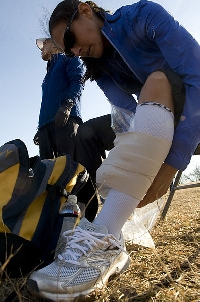
Taping shin splints provides much needed pain relief and muscle support
If you?ve ever played a sport in school, you?re likely familiar with shin splints. Not everyone gets them, but those who do can be quite verbal about the pain. The term shin splints, or Periostitis, is often used to refer to any pain at the front of your lower leg. Actual shin splints occur inside the front of the shin bone. Taping shin splints provides support and relief to this slow healing, painful condition.
If you suspect you have developed shin splints, many trainers recommend having a professional check your injury before you attempt taping shin splints yourself. Self treatment is handy when the diagnosis is correct, but if your injury is more serious than shin splints you could end up doing more damage. If you do have shin splints, taping them removes pressure from the muscle, enabling the shin to rest so it can heal.
The main cause of shin splints is inflammation around the sheath surrounding the shin bone. The stresses of running, dancing, jumping and sprinting often lead to this inflammation.
The symptoms of shin splints include:
-Pain at the front of your lower legs when you begin exercise, after activity and the following day.
-Swelling around the shins.
-The inside of the shin feels bumpy.
-Pain when you curl your toes or foot down.
-Pain around the bottom interior of the shin.
Taping shin splints
Materials needed:
1 inch non stretch athletic tape, underwrap, skin adhesive
Tape provides the first layer of support for your shin, but it can only be effective if it sticks to your skin properly. This means that the best way to apply tape is to first shave the bottom portion of the leg. The alternative is to apply underwrap first and apply the tape to the underwrap, which will not be as effective for pain relief, but may be more agreeable to fellows.
~
Step 1 ? Beginning at the bony inside of your ankle, wrap the tape diagonally across your ankle, over the achilles tendon and diagonally across the upper shin. Be careful not to wrap too tightly. If it feels too loose or too tight, try it again until the tape feels supportive. Applying the tape too tightly around the achilles tendon will increase the pain.
Step 2 – Repeat step one two more times with a slight overlap on each seam. Make sure to cover the painful areas.
The Runner?s World Taping Method
Runner?s World recommends Kinesio Tex Tape for taping shin splints. Professional runners prefer this adhesive because it speeds healing, but doesn?t limit the range of motion. The tape costs about $15 per roll and can stay on for five days.
Step 1 – Use a length of tape about 12-18 inches.
Step 2 – With a flexed foot, wrap the tape around your foot beginning below the small toe and arcoss the highest point of your arch. Run the tape up the front of your shin.
Step 3 – Cut about 6 inches of duct tape, 1 ® inches wide. Flex your foot and wrap the duct tape around the outside of the Kinesio tape, pulling tautly over the arch to provide extra support.
Taping shin splints is one step you can take to treat your pain. Effective recovery steps also include restoring the muscles and slowly returning to training. Icing you shins before taping, and applying anti inflammatory medications are commonly used to reduce the pain.
If you?re suffering from shin splints, as annoying as it may be to pause your training, it?s essential to treat your injury. Whether you?re preparing to run a marathon or trying to improve your overall fitness, the quickest way to get back on your feet in the best condition possible is to address injuries as soon as they occur.
References:
Runner’s World: Taping Shin Splints
KT Tape: Shin Splints

